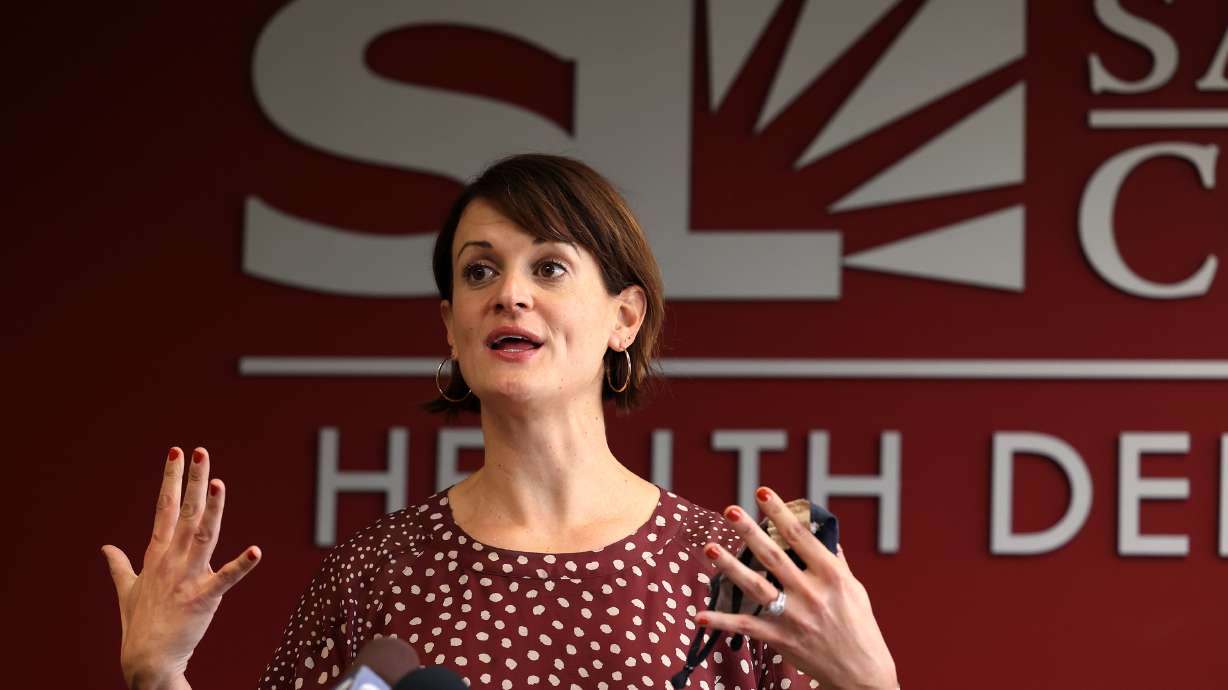Estimated read time: 5-6 minutes
This archived news story is available only for your personal, non-commercial use. Information in the story may be outdated or superseded by additional information. Reading or replaying the story in its archived form does not constitute a republication of the story.
SALT LAKE CITY — Although the number of new COVID-19 cases reported on Wednesday is higher than any single day since January, Utah health officials plan to follow the latest U.S. Centers for Disease Control and Prevention guidance and shorten quarantine recommendations to five days.
Dr. Angela Dunn, executive director of the Salt Lake County Health Department and former state epidemiologist, said Wednesday that the new CDC guidance took public health officials across the nation by surprise. She said the county health department has been scrambling since the announcement to make sure that it is on the same page with the state health department and other local health departments in applying the new guidance.

Under previous CDC recommendations, unvaccinated people were advised to quarantine for 10 days after exposure without a test or for seven days with a negative test. Now people should quarantine for five days and continue to wear a mask for five additional days. Recommendations for people who are fully vaccinated but exposed to the virus remain to mask but not quarantine. Anyone who tests positive or has symptoms was previously asked to isolate for 10 days and until symptoms have been gone for 24 hours, but now they will be asked to isolate for only five days.
Dunn said that this change does come with a risk that it could lead to more infections than anticipated with the more contagious omicron COVID-19 variant, and more hospitalizations. Dunn said her biggest fear is that people will see the recommendations and think it is safe to go out after five days when that is not necessarily true. Masking, she said, is a big part of the recommendations, and there is a risk involved.
"For those people out there who might be at high risk for severe disease due to COVID, definitely get vaccinated, but then other than that, make sure you're wearing a mask and not going to large public gatherings," Dunn said. "Because there is a potential for more people who are still infectious to be out there."
Dunn explained that Salt Lake County Health plans to follow the new CDC guidance for health care workers and the general population immediately, but department officials want to make sure that the public understands the reasons for the change and the risks involved so that they can make the best decisions for themselves. Health officials are still looking at how the recommendations will affect current guidance for high-risk settings including K-12 schools and jails.
Shortly before the change was made, airline industry executives asked the CDC to consider shortening quarantine recommendations because the high number of employees on quarantine and unable to work led to canceled flights. Dunn said that there have been similar issues in Utah, and that this change will help essential workers as well as industries that drive the economy to continue operating.
For example, Dunn said Alta Ski Area had multiple employees with breakthrough infections who were unable to work, leaving it short-staffed near the beginning of the ski season. At that time, the company talked to the county health department about quarantine lengths and what the latest science was showing to support them.
Dunn said that this latest change was not due to robust scientific evidence showing that the omicron variant is not infectious after five days. There is some scientific evidence showing that it could be less contagious after that period of time, but because the variant is so new, there remains a lot that still isn't known.
"I think it's so important for people to understand why this was shortened, and it really was shortened to keep our economy going and to ensure that we have those essential services available to us as a society," Dunn said.
She said the change does not mean that people should go to voluntary large group events during that time because there is still a risk of high transmission, but that they can wear a mask and go to work as long as they are feeling well enough.
"We're at the beginning of our omicron surge right now, and it's the holiday season, so I think we're all anticipating the regular surge after a holiday but then in addition, omicron hitting us at the same time," Dunn said.
With the shortened quarantine recommendations also comes less of a push for testing, and no option to "test out" of quarantining after exposure. Dunn said that the CDC recognizes that there is a shortage of tests and that testing will be optional for quarantine under these recommendations.
The CDC explained when it halved the recommended quarantine time that there is science showing that the majority of SARS-CoV-2 transmission occurs in the few days before and after the onset of symptoms. Therefore, people who test positive with the virus should isolate for five days, and, if they remain asymptomatic through that time, they may leave isolation if they can continue to mask for five days to minimize the risk of infecting others.
CDC director Dr. Rochelle Walensky said that the omicron variant is spreading quickly and has the potential to have a large impact.
"CDC's updated recommendations for isolation and quarantine balance what we know about the spread of the virus and the protection provided by vaccination and booster doses. These updates ensure people can safely continue their daily lives. Prevention is our best option: get vaccinated, get boosted, wear a mask in public indoor settings in areas of substantial and high community transmission, and take a test before you gather," Walensky said.









